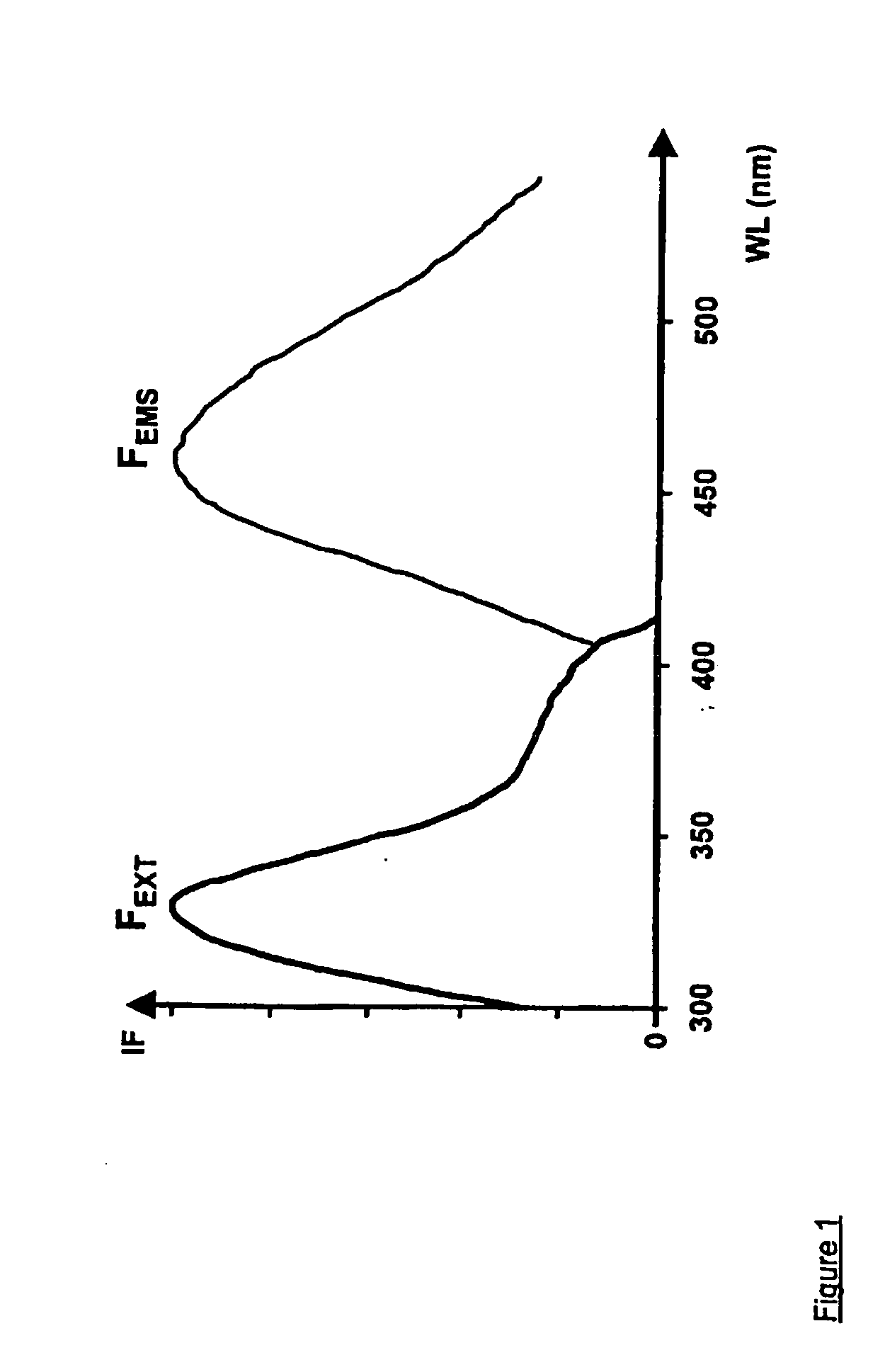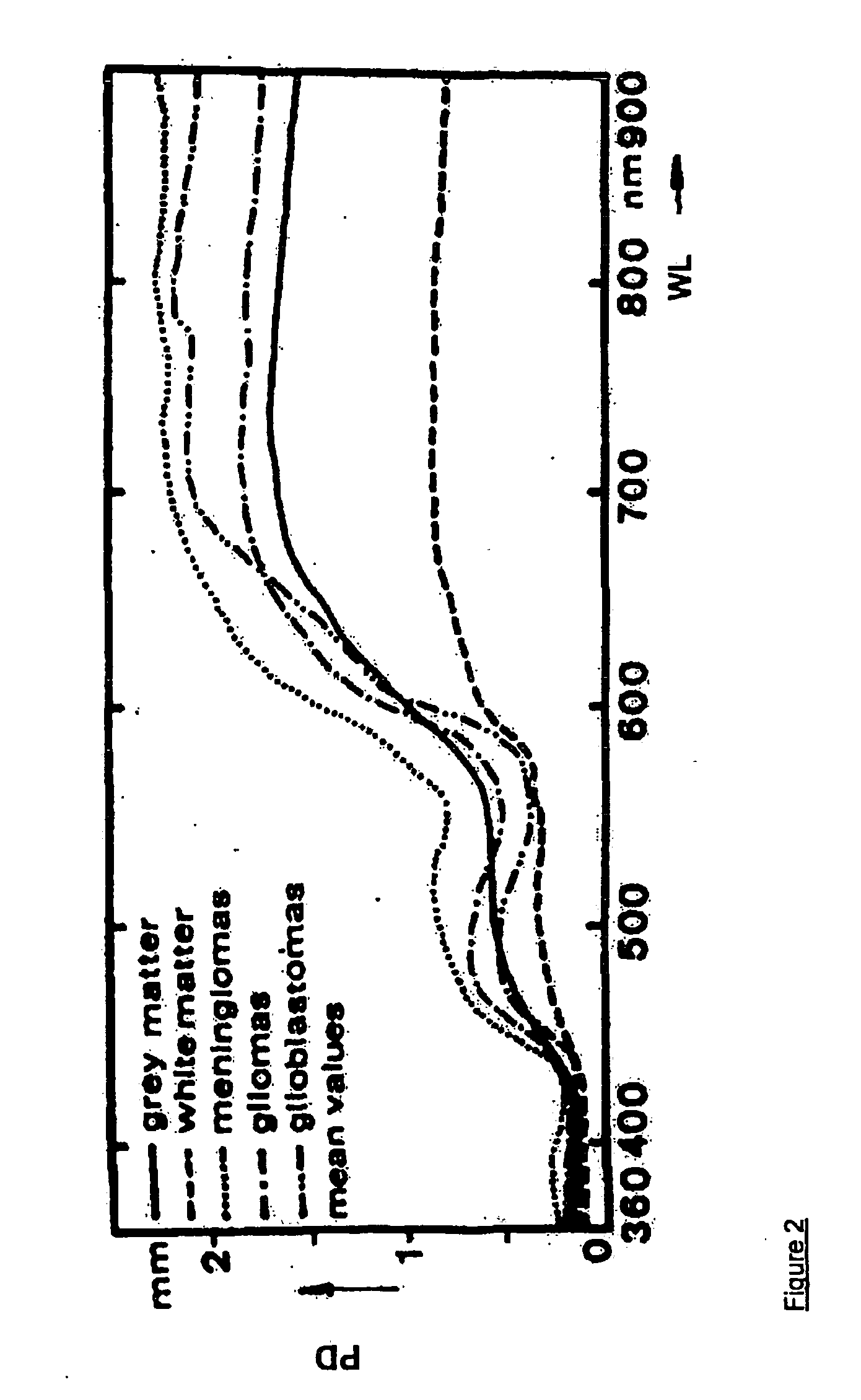The concentration of the reduced form of the molecule (NADH) rises when the rate of
ATP production is low, and is unable to meet the demand in the tissue or cells.
Fp concentration drops when the rate of
ATP production is reduced, and is unable to meet the demand in the tissue or cells.
An increase in the level of NADH with respect to NAD and the resulting increase in
fluorescence intensity indicate that insufficient
Oxygen is being supplied to the tissue.
These devices are relatively complicated and susceptible to interference from ambient light, as well as various electronic and optic drifts.
For the monitoring of different parameters to have maximum utility however, the information regarding all parameters is required to originate from substantially the same layer of tissue, and preferably the same volume of tissue, otherwise misleading results can be obtained.
A particular drawback encountered in NADH measurements is the Haemodynamic Artifact.
This refers to an artifact in which NADH
fluorescence measurements in-vivo are underestimated or overestimated due to the haemoglobin present in
blood circulation, which absorbs
radiation at the same wavelengths as NADH, and therefore interferes with the ability of the light to reach the NADH molecules.
However, U.S. Pat. No. 4,449,535 has at least two major drawbacks; firstly, and as acknowledged therein, using a single
optical fiber to illuminate the organ, as well as to receive emissions therefrom causes interference between the outgoing and incoming signals, and certain solutions with different degrees of effectiveness are proposed.
This results in measurements that are incompatible one with the other, the
blood volume measurement relating to a greater depth of tissue than the NADH measurement.
Therefore, the device disclosed by this reference does not enable adequate compensation of NADH to be effected using the simultaneous, though inappropriate, blood
volume measurement.
Further, there is no indication of how to measure other parameters such as
blood flow rate or
blood oxygenation level using the claimed apparatus.
Although U.S. Pat. No. 5,916,171 and U.S. Pat. No. 5,685,313 represent an improvement over the prior art, they nevertheless have some drawbacks: (i) The oxidation level of the blood will introduce artifacts, affecting both the Mitochrondrial
Redox State measurement (NADH
fluorescence) and the microcirculatory blood volume (MBV) since these patents do not specify how to compensate for the
oxygenation state of the blood in the tissue, i.e., the relative quantities of oxygenated blood to deoxygenated blood in the tissue.
Using a relatively
high intensity UV laser illumination source as proposed raises safety issues, especially for long-term monitoring.
At higher wavelengths, between 370 nm and 400 nm, the NADH excitation spectrum provides sharply diminished excitation intensities, and a man of ordinary skill in the art would thus not normally be motivated to use a radiation source operating at these wavelengths, since the
fluorescent radiation from the tissue would effectively be of corresponding low intensity, and therefore difficult to measure accurately.
Such a second excitation spectrum could interfere with and thus introduce errors in the NADH measurement.
Furthermore, at the time when these US patents were filed, and indeed until very recently, there were no suitable lasers available capable of generating electromagnetic energy in the
wavelength range 370 nm to 400 nm, or indeed in the range 400 nm to about 470 nm with sufficiently low
Relative Intensity Noise factor (RIN).
There is also a small but significant spectral spread at the operating
wavelength, typically comprising about eleven discrete wavebands bundled thereabout, further diminishing the efficiency of operation.
While this laser enables single illumination radiation for laser Doppler flowmetry and NADH monitoring, the sensitivity is very low, and operation of such a laser raises many safety issues, since operating at a wavelength of 325 nm carries
potential risk of
DNA damage to the tissue.
While this laser generates less
noise in
pulse mode, no useful measurements may be made for Doppler Flowmetry using pulsed lasers, since it is very difficult to ensure uniformity between the pulses generated.
Furthermore, there would be little motivation for a man of the art to use a laser at the illuminating
wavelength range of 370 nm-400 nm, or indeed in the range of about 400 nm to about 470 nm for laser Doppler Flowmetry, even if one existed, for a number of reasons.
In such a method, severe constraints are imposed on the laser spectral bandwidth that is acceptable for the task.
Broad laser bandwidth causes blurring of the interference fringes, thereby decreasing the quality of the measurements.
However, there are further problems associated with using an illuminating radiation wavelength in the range 370 nm to 470 nm that teach away from using such a laser wavelength for Doppler flowmetry:— (a) Firstly, the magnitude of the actual DC
signal is lower than with higher-wavelength lasers because of higher tissue and blood absorption as well as higher scattering, which therefore results in lower sensitivity in the measurement of the AC / DC ratio.
(b) Secondly, safety issues are raised with using such a laser
wavelength range, as described in greater detail hereinbelow.
(c) Thirdly, the
optical noise generated by the laser, while not a severe problem with high-wavelength lasers, in UV lasers this can be of the same order as the Doppler
signal itself, thereby obscuring the parameter being measured.
(d) Fourthly, detectors capable of detecting the AC component of the radiation received from the tissue are not generally very sensitive in the
wavelength range 370 nm to about 470 nm, which of course lowers further still the chances of successfully using Doppler flowmetry at this wavelength range.
At low illuminating wavelengths, the
speckle pattern is considerably smaller than at higher wavelengths, which lowers the possibility even further of such speckles being detected and measured in the first place.
All the above problems individually, and more so in combination, teach away from considering the use of a laser in the 370 nm to 470 nm range for measuring blood flow rate together with blood NADH or with Fp, since the combined inefficiencies reduce the possibility of providing meaningful flowmetry results.
However, even if the problem of
decreased sensitivity is resolved, there are yet another two problems that dissuade the use of such lasers in the present context.
Until recently, no laser diodes capable of operating at these isosbestic wavelengths were available.
However, even these lasers are still subject to the above problems.
Secondly, even the existence of such a laser in and of itself does not render its use obvious in the context of laser Doppler flowmetry and NADH monitoring.
For example, if such a laser were to be used in combination with the device disclosed in U.S. Pat. No. 5,916,171 and U.S. Pat. No. 5,685,313, the device would still be incapable of providing meaningful Doppler flowmetry measurements.
While lasers generate
electromagnetic radiation nominally at a single wavelength, in practice, this is not achieved, and two or more discrete narrow wavebands are generated.
A further problem associated with longitudinal multi-mode radiation is the phenomenon of mode competition, in which the actual wavelength of the illuminating radiation randomly switches from one of the discrete
modes or wavebands to another, which dramatically increases the level of RIN.
Finally, even if such a
laser diode were to be configured to generate radiation in nearly longitudinal single mode by critical choice of current and temperature, which is in itself far from self-evident, factors such as temperature and current drifts may cause regression to multi-mode operation.
Furthermore such single mode operation still has intrinsically a very
broad bandwidth in order of 400 Mhz, which of itself is still problematic for laser Doppler flowmetry.
Thus, all the above factors would tend to teach away from employing such a laser configuration for multiparamater monitoring In fact, even a
grating-stabilized
laser diode that nominally operates in a single
longitudinal mode exhibits intensity
instability.
Due to such changes the laser
system gradually drifts to highly unstable multimode operation accompanied with very high optical
noise caused by mode competition.
This requirement implies a severe limitation on the
light intensity emitted by the distal tip of the
fiber optic probe, particularly when shorter wavelength, higher intensity radiation is used.
 Login to View More
Login to View More  Login to View More
Login to View More 


